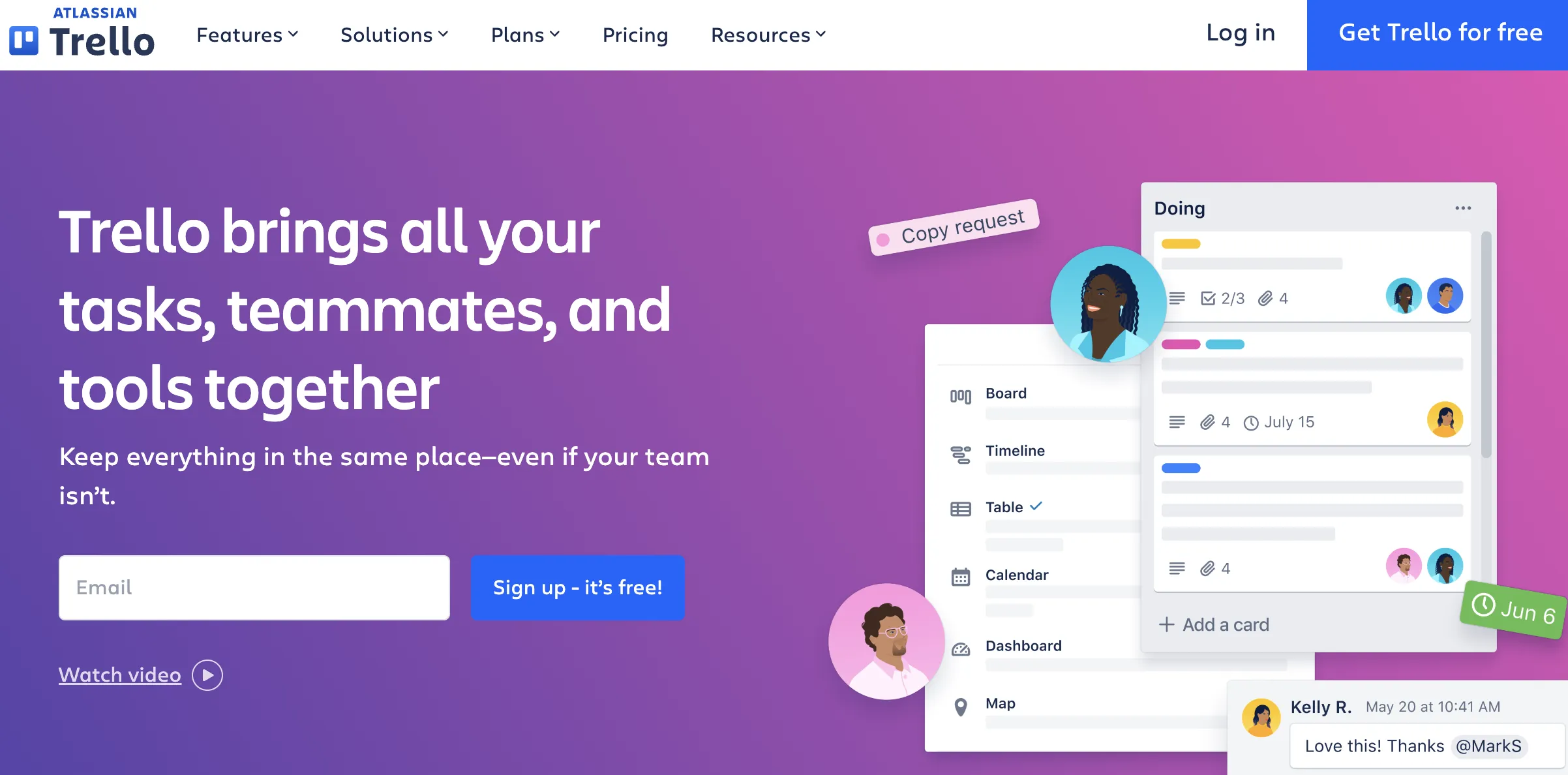Marketing and sales teams rely heavily on one another to drive business. After all, it’s the marketing department that generates leads, and the sales team that converts those leads to paying customers.

It’s not intuitive, then, that these two functions often exist in silos, each having their own systems and processes. Sales collaboration dramatically improves results, but bringing it to fruition can be more complex than it sounds.
In this article, we discuss how sales and marketing collaboration makes a difference and provide tips and tools for making this collaboration more efficient.
Table of Contents
- How can Sales and Marketing collaborate?
- Types of Sales Collaboration
- Why Collaboration Matters
- Tools that Foster Collaboration
- 6 Tips for Collaboration
How can sales and marketing collaborate?
Sales and marketing teams today must break away from traditional silos and forge powerful, collaborative alliances. Meeting goals requires CSOs and CMOs to intertwine their unique roles and focus on unified, revenue-generating activities that support both go-to-market strategy and operational execution.
How? Let’s have a look at five key areas where these two departments should collaborate.
Customer Messaging
One of the most obvious signs of misalignment between sales and marketing teams is during direct customer interactions.
Customers pick up on disparities in how the brand is presented or inconsistencies in responses from both teams. This gap confuses the customer and dilutes the brand’s image and credibility.
Marketing teams, with their rich industry insights, often take the lead in crafting the messaging platform. But relying on this alone misses the mark.
Customer interaction allows sales teams to gain first-hand feedback and insights into what resonates. They understand the intricacies of customer pain points, their desires, and the terminologies of the most impactful content.
Blending an industry-centric approach with on-ground, practical insights sculpts a sales messaging playbook that’s consistent and engaging. Collaboration makes it possible for messaging to evolve based on real-time feedback.
A joint effort in shaping customer messaging ensures brand consistency and harnesses the voice of the customer. The result? Messages hit home every time.
Enablement Content
Enablement content sits at the crux of successful sales and marketing alignment. It bridges the knowledge and tools that sellers need with the creative and informational prowess of marketers.
Let’s take a closer look with some examples:
- Product datasheets. Marketing might create a datasheet highlighting product features, benefits, and USPs. Sales, with their in-depth customer insights, suggest refinements that emphasize points that resonate most with potential buyers.
- Case studies. While marketing compiles success stories, sales teams provide real anecdotes and feedback from clients, which makes the case study more authentic and compelling.
- Training webinars. Sales teams, needing up-to-date product knowledge, benefit from training sessions from marketing. Post-training, sales provides feedback, ensuring subsequent webinars are even more tailored and effective.
The secret sauce? Pre- and post-deployment feedback on materials. Feedback ensures enablement content is as effective and relevant as possible.
A continuous feedback loop allows marketing to iterate upon and refine content, focusing on what sellers need to know, articulate, display, and execute in their roles.
Lead Scoring and Prioritization
Sales and marketing teams can develop and refine a lead scoring system that identifies and prioritizes potential customers based on specific criteria. A joint effort attracts the right kind of leads, with the sales team focusing its energy on prospects with the highest likelihood of conversion.
Consistent communication and feedback loops fine-tune criteria and scoring mechanisms to optimize the quality and conversion rates of leads. Start with these criteria.
- Behavioral signals: Monitoring actions such as website visits, downloads, webinar attendance, and email click-through rates to gauge interest levels.
- Demographic information: Use factors like job titles, company size, and industry to match leads with ideal customer profiles.
- Engagement level: Regular interactions with marketing campaigns, responsiveness to emails or calls, and active participation in events or seminars.
- Buying intent: Use of specific keywords in queries, visits to pricing pages, or requests for product demos hint at a lead’s readiness to purchase.
- Past interactions: Historical data on previous purchases, inquiries, or feedback provide context on a lead’s potential.
A collaborative lead-scoring approach ensures high-quality lead generation. Sales also prioritizes its efforts on leads with the highest conversion potential. A joint strategy streamlines operations, reduces resource waste, and boosts the overall efficiency of the sales funnel.
Types of Sales Collaboration
Sales collaboration manifests in various forms, each with its own purpose and benefit. Teams can better use their collective potential by understanding the different types of collaboration. Let’s delve into some prominent types:
Vertical Collaboration
Vertical collaboration is the interaction and alignment between different hierarchical levels within an organization. A management–frontline sales team or a senior leadership–middle management relationship are great examples of sales collaborations.
Suppose a regional sales manager collaborates with individual sales reps to understand ground-level challenges and provide tailored strategies and resources.
A top-down collaboration allows insights from the field to inform higher-level decision-making.
Horizontal Collaboration
Horizontal collaboration happens between teams or individuals of the same hierarchical level but across different departments or functions. It’s all about breaking down silos and making sure peer teams work together, like sales and marketing.
For example, the sales team collaborates with the product team to understand new features.
Sales reps communicate the benefits of this feature to potential clients and ensure consistency in messaging and better customer understanding.
Why Collaboration Matters
Our survey offered some juicy insights from salespeople on how transformational their collaboration with marketing is.
.webp)
Let’s discuss some of these insights below:
1. Improves Customer Experience
Customer experience is the impression your customers have of your brand as a whole throughout all aspects of the buyer’s journey. It influences their perceptions and feelings about your business.
When there’s alignment between sales and marketing, they create consistent messaging that provides value at each touchpoint. Our survey shows that 28% of salespeople stated that the most significant advantage of sales and marketing alignment is the improved customer experience it brings.
The sales team also conveys real-time feedback to the marketing team, ensuring campaigns and content are timely, relevant, and resonate with customers.
And why is this seamless experience essential? It makes the sales process smoother and leaves a lasting positive impression on the customer. This impression has tangible benefits — after all, consumers are 5.1 times more likely to recommend an organization after a positive customer experience.
Such advocacy boosts brand reputation and plays a crucial role in driving organic growth through word-of-mouth referrals. When teams collaborate, customers win — and so does the business.
2. Improves Lead Quality
Lead quality refers to the potential of a lead, or a prospective customer, to become a paying customer based on various indicators such as their engagement, fit, and buying intent.
The importance of lead quality cannot be overstated — high-quality leads are more likely to convert into actual sales, ensuring efficient use of resources and higher revenue generation.
As many as 44% of sales reps express concerns about the quality of leads they receive. This substantial percentage underscores a major pain point within many organizations.
But when sales and marketing teams find alignment, things take a turn for the better. A significant 26% of professionals have noted an increase in lead quality when these two crucial departments collaborate effectively.
When both teams are on the same page regarding the ideal customer profile, marketing generates campaigns that attract the right audience, ensuring sales focuses on genuinely promising prospects.
3. Increases Revenue
The bottom line, or revenue, is the lifeblood of any organization. It’s a direct reflection of the business’s health, sustainability, and growth potential.
While numerous factors influence revenue, so does the alignment of sales and marketing teams. In fact, 32% of respondents in our survey said that revenue growth was the most significant benefit of such alignment.
Here’s how alignment boosts profits:
- Efficient Resource Utilization: Reduced wastage in targeting unqualified leads or mismatched audiences ensures every dollar spent yields better returns.
- Consistent Messaging: A unified brand message increases trust and accelerates the sales cycle, leading to quicker conversions.
- Improved Lead Quality: Better leads mean higher conversion rates, translating to more sales and, consequently, higher revenue.
- Informed Decision-making: Real-time feedback loops enable swift adjustments to strategies, ensuring that efforts are always directed toward revenue-generating activities.
- Enhanced Customer Experience: Happy customers not only buy more but also become brand advocates, driving referral sales.
4. Better Understanding of Customers
Understanding customers is like possessing the compass that guides a business in its journey.
It determines product development, marketing strategies, and sales tactics. The deeper and more nuanced this understanding, the better equipped a business is to meet and exceed customer expectations.
According to our survey, 21% of salespeople said that a cohesive marketing and sales team enhances understanding of customers. Clearly, collaboration is key to figuring out customer needs, behavior, and preferences.
Brands find themselves disconnected from their consumers. A survey revealed that less than half of the brands feel they have successfully integrated the necessary elements — tech, metrics, customer journey mapping, team alignment, data, and channels — for optimal digital engagement.
By aligning sales and marketing:
- Businesses integrate diverse data points to gain a 360-degree view of customers.
- The insights from direct customer interactions (sales) inform marketing strategies and vice versa, enriching the overall customer profile.
- Teams address pain points in the customer journey, ensuring a seamless and memorable experience.
Tools That Foster Collaboration
The right tools facilitate collaboration between teams. Streamlining processes, fostering communication, and providing insightful analytics, these tools work together and work smarter. The following tools can help sales and marketing teams collaborate better:
1. HubSpot
.webp)
Best for: Businesses looking for an all-in-one solution to align their sales and marketing teams and strategies.
HubSpot is a comprehensive platform that integrates CRM, sales, marketing, and customer service functionalities. It offers a comprehensive set of inbound marketing tools, including email automation, SEO tools, and social media management tools.
As part of the sales features, it has a dedicated dashboard, precise deal tracking, and seamless lead management.
These tools come together under a unified analytics framework that allows teams to monitor and evaluate performance across both sales and marketing domains. This cohesion ensures every user accesses and uses insights, fostering collaboration and strategic alignment.
Pricing: Free; Starter, $18/mo; Professional, starts at $1,600/mo.
2. Trello

Best for: Small to medium-sized teams seeking an intuitive and flexible tool to streamline task management and enhance team collaboration.
Trello is an intuitive visual project management system, which uses cards and boards to track and organize tasks. It offers customizable workflows with an easy-to-use drag-and-drop interface that allows teams to tailor their processes to specific project needs.
With Trello, integrate a variety of popular tools, including Slack and Google Drive.
It also encourages team collaboration by allowing users to attach files, add comments, and build comprehensive checklists directly onto cards. This functionality simplifies task management and promotes communication and transparency among team members.
Pricing: Free; Standard, $5 per user/month if billed annually; Premium, $10 per user/month if billed annually; Enterprise, $17.50 per user/month if billed annually.
3. Slack
.webp)
Best for: Teams looking for seamless communication and integration with other collaboration tools.
Slack’s real-time messaging capabilities have revolutionized team communication. It enables seamless file sharing and allows integrations with various productivity tools.
The platform organizes conversations through channels, allowing for both team-specific and project-specific discussions. Direct messaging facilitates private one-on-one chats, perfect for quick clarifications or personal conversations.
Slack also incorporates voice and video call functionalities that provide teams with diverse means to connect and collaborate. This holistic approach ensures communication flows smoothly, regardless of the team size or project complexity.
Pricing: Pro, $7.25 per person/month, when billed yearly; Business+, $12.50 per person/month, when billed yearly; Enterprise Grid: Custom.
4. Loom

Best for: Remote sales and marketing teams looking for an easy way to communicate product demos, feedback, or quick updates without requiring live meetings.
Loom simplifies asynchronous communication and allows teams to convey information more personally and vividly than through text alone. Its ease of use and quick video-sharing functionality make it a favorite for many remote teams.
Users can choose from different recording modes: camera-only, screen and camera, or just the screen. Loom provides simple editing tools like trimming for refining videos. Plus, it integrates well with tools such as Slack, Trello, and Notion.
Pricing: Starter, Free; Business, $12.50 user/month; Enterprise, Custom
6 Tips for Collaboration
We asked five thought leaders for their top tips on sales and marketing collaboration. Let’s have a look:
1. Think holistically about your funnel.
“Stop ‘tossing leads over the fence’ or ‘handing them off’ to sales. It’s just the funnel, and conversion can require marketing and sales touches at every step.”
—Brian Zang, Senior Vice President of Revenue at Cloverly
Here’s the truth: Sales and marketing aren’t two separate entities, but rather two interconnected phases in the customer journey.
The funnel, from awareness to conversion, isn’t linear and, instead, is a continuum where marketing efforts feed into sales, and feedback from sales loops back into marketing.
Considering the funnel holistically means that both sales and marketing teams understand the entire process, not just their part of it.
This broader perspective ensures that marketing activities align with what the sales team needs and vice versa.
2. Define MQLs and SQLs for your business and your funnel.
“When do you want a salesperson to engage? When should marketing own the lead? How can sales automatically adjust paths after a phone conversation? Put practices in place that understand sales and marketing will have to work together to maximize conversion.”
—Brian Zang, Senior Vice President of Revenue at Cloverly
MQLs (Marketing Qualified Leads) and SQLs (Sales Qualified Leads) are crucial distinctions. Define these to bridge the gap between marketing’s lead generation and sales’ conversion efforts.
An MQL is typically a lead that’s engaged with the company’s marketing initiatives but hasn’t yet shown the buying intent. An SQL, on the other hand, has displayed a clear interest in purchasing and is ready for the sales team’s direct outreach.
Setting clear criteria for MQLs and SQLs requires an understanding of the circumstances under which a lead progresses through the funnel. Both teams should address questions like:
- What actions or engagement levels make a lead an MQL?
- When does an MQL transition to being an SQL?
- What signals from the lead show they’re ready for a purchase conversation?
Addressing these questions and setting specific criteria ensures smoother transitions and better alignment.
3. Make sure each department understands what each side is held accountable for.
“We have implemented monthly Smarketing (Sales + Marketing) meetings in order to get everyone on the same page. This gives the two teams a chance to be in the same room and discuss what has or has not been working and what each team needs from the other in order to be successful. Understanding the functionality of a well-oiled ‘smarketing’ machine can be the one factor between a company that fails and one that succeeds.”
—Erin Fradelos, Senior Director, Global eCommerce and Digital Marketing at Owl Labs
Clarity in roles and responsibilities facilitates effective collaboration. Understand what each department is held accountable to prevent overlaps, fill gaps, and streamline efforts.
Regular meetings where both teams discuss their objectives, KPIs, and deliverables are great for this. These meetings foster open dialogue, enabling team members to ask questions, provide feedback, and share insights.
Marketing then tailors their campaigns to feed the sales pipeline, while sales offers on-the-ground feedback to fine-tune marketing strategies. When each side knows what the other is accountable for, it enhances teamwork and drives toward a unified company goal.
4. Implement Real-Time Lead Notification Systems.
“In order to closer align these efforts, marketing teams need to provide sales with increased visibility into how prospects are interacting with marketing collateral and next-generation analytics that can let sales teams know when and how to reach out to leads.”
—Joe Moriarty, VP of Sales and Marketing at Raven360
Conventionally, sales teams may be left in the dark until a marketing campaign concludes. However, prospects often show their peak interest during these campaigns. This is the opportune moment for sales teams to strike.
Establishing a system where sales gets real-time alerts about lead interactions with marketing collateral ensures they engage prospects when the iron is hot.
The real-time lead notification system may include:
- Alerts on engagement. Notify sales when leads interact with emails, download content, or visit key web pages.
- Behavioral insights. Share data about what specific content the lead is interacting with.
- Immediate follow-ups. Ensure sales acts instantly, capturing leads in their moment of interest.
Reduce the lag between a lead’s interaction and the sales team’s outreach to get a better chance of converting interest into tangible business opportunities.
5. Measure the respective goals and incentives for sales and marketing.
“It’s important to have measurement criteria tied to their respective incentives. True collaboration can only exist between marketing and sales if they both have goals and incentives tied to the performance of each other’s camp.”
—Rob Nance, Communications at JPMorgan Chase & Co.
Have defined metrics that reflect both teams’ goals and incentives. Create measurement criteria that are specific, measurable, attainable, relevant, and time-bound. For example, marketing might measure lead generation numbers or the quality of leads (like MQLs), while sales focuses on conversion rates and revenue targets.
Regular evaluation identifies areas for improvement and ensures both teams are on track. But it’s also essential that the measurement criteria align with incentives.
If a marketing team’s incentive is solely on the quantity of leads, but sales require quality, a disconnect can arise. Measuring and aligning goals and incentives helps both departments work in harmony towards shared company objectives.
6. Get on sales calls.
“Marketing is all about knowing your audience, and taking sales calls allows you to get to know them first hand. After a week of taking the occasional call, I felt like I knew our clients personally and that I could better target their needs in our initial online touches.
—Alex Avritch, Sr. Brand Engagement Manager, LaunchDarkly
Having marketing team members participate in sales calls can offer invaluable insights into the customer’s journey and decision-making process. Here’s why this tip is significant.
- Direct feedback: Instead of relying on second-hand information, marketers can hear directly from prospects and customers about their pain points, objections, and preferences.
- Refining messaging: Hearing objections or questions first hand enables marketing to adjust their campaigns and content to address common concerns more effectively.
- Building empathy: Listening to sales calls can help marketers truly understand the challenges and nuances sales teams face, leading to more supportive and targeted materials.
- Closing the feedback loop: Post-call debriefs between sales and marketing can identify gaps in communication or information that need to be addressed.
Incorporating marketers into sales calls, even if occasionally, can bridge the understanding gap, making collaboration between the two departments even more effective.
Create a Cohesive Sales and Marketing Journey
Fostering collaboration ensures a synchronized approach that amplifies their efforts, rather than diluting them. The key is to prioritize open communication, shared objectives, and real-time data-sharing.
When both teams operate with a unified vision, it enhances the customer’s experience, from the first touchpoint to the final sale. The result? A more efficient pipeline, better conversion rates, and a stronger bottom line.
![Download Now: 2024 Sales Trends Report [New Data]](https://no-cache.hubspot.com/cta/default/53/9cdc68ed-d735-4161-8fea-0de2bab95cef.png)






![125 Sales Experts to Follow on Twitter [Infographic]](https://blog.hubspot.com/hubfs/00-Blog_Thinkstock_Images/studying.jpg)



![CRM Expert Paul Greenberg Defines Customer Engagement [Interview]](https://blog.hubspot.com/hs-fs/hub/53/file-686515960-png/Blog-Related_Images/paul-greenberg-customer-engagement.png)